You think I’m not aware that I’m the voyeur god of this story? Standing outside the gutters and frames of the comic book panels, sure, that is where the gods and demons, the archons and aliens lurk. In the post-modern, fourth-wall-breaking context. The reader though, the reader is outside the entire framework. What does Morrison call it, in the end? The supercontext. But just how outside of it are you? Grant Morrison is outside of the comic, but he (with his artistic collaborators) created it and delivered it to you, like an infection, or a vaccine. Heck, it is even outside of time; Grant Morrison writes the message over a period of years, from 1994 to 2000, and I start reading it right at the tail end of 2012. Right at the end of the world. Ragged Robin is 33 years old in 2012, and so am I, at the end of the world, and I’m right in the middle of the supercontext.
 Sorry, I just finished reading The Invisibles, and traces of the drug are still in my system, so to speak. So let me get this out of the way, right at the beginning: I think Grant Morrison is the bee’s knees. That doesn’t mean I think he can do no wrong, though, and I should include the caveat that I think right now Grant Morrison is better than the Grant Morrison in the past. In a nutshell, I think All-Star Superman is one of the greatest comic books of all time; hopefully the herald of the new Renaissance, as Kingdom Come was the end of the Dark Ages (whereas The Watchmen was the beginning). I’m not a comics scholar—I’m sure others would disagree with my demarcations—but I think All-Star Superman is important, like, important on a historical, literary scale.
Sorry, I just finished reading The Invisibles, and traces of the drug are still in my system, so to speak. So let me get this out of the way, right at the beginning: I think Grant Morrison is the bee’s knees. That doesn’t mean I think he can do no wrong, though, and I should include the caveat that I think right now Grant Morrison is better than the Grant Morrison in the past. In a nutshell, I think All-Star Superman is one of the greatest comic books of all time; hopefully the herald of the new Renaissance, as Kingdom Come was the end of the Dark Ages (whereas The Watchmen was the beginning). I’m not a comics scholar—I’m sure others would disagree with my demarcations—but I think All-Star Superman is important, like, important on a historical, literary scale.
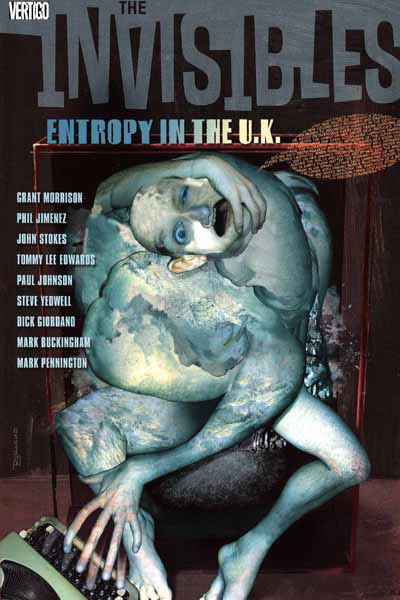 I mention all this because I think the twin strands of All-Star Superman’s DNA are Morrison’s work on JLA—obviously—and his work on The Invisibles. They were contemporaneous—1996 to 2000 for his run on JLA— and they came at seemingly right angles to each other. JLA was about the superhero as divinity, and The Invisibles… well, “what is The Invisibles about?” is actually a really great question. A meditation on…order and chaos? A magical initiation, in a graphic narrative format? A discussion on the nature of reality and enlightenment? It’s philosophy! No, crass entertainment! I suppose we could rattle off theories like that all day and the answer to all of them would be “Sure.” As the comic itself puts it, when talking about the meta-text: “It’s a thriller, it’s a romance, it’s a tragedy, it’s a porno, it’s neo-modernist kitchen sink science fiction that you catch, like a cold.” The Invisibles is Grant Morrison’s kitchen sink. Ultimately it ends up being tautology: The Invisibles is The Invisibles. You know the first rule of Tautology Club. The First Rule of Tautology Club is the First Rule of Tautology Club.
I mention all this because I think the twin strands of All-Star Superman’s DNA are Morrison’s work on JLA—obviously—and his work on The Invisibles. They were contemporaneous—1996 to 2000 for his run on JLA— and they came at seemingly right angles to each other. JLA was about the superhero as divinity, and The Invisibles… well, “what is The Invisibles about?” is actually a really great question. A meditation on…order and chaos? A magical initiation, in a graphic narrative format? A discussion on the nature of reality and enlightenment? It’s philosophy! No, crass entertainment! I suppose we could rattle off theories like that all day and the answer to all of them would be “Sure.” As the comic itself puts it, when talking about the meta-text: “It’s a thriller, it’s a romance, it’s a tragedy, it’s a porno, it’s neo-modernist kitchen sink science fiction that you catch, like a cold.” The Invisibles is Grant Morrison’s kitchen sink. Ultimately it ends up being tautology: The Invisibles is The Invisibles. You know the first rule of Tautology Club. The First Rule of Tautology Club is the First Rule of Tautology Club.
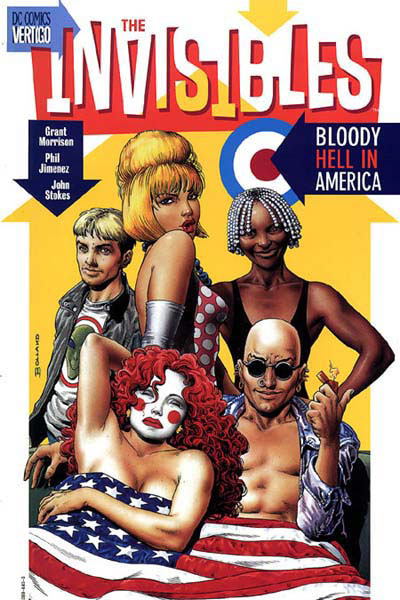 Ultimately, The Invisibles is what I’d call a “very young work.” With all the good and ill that entails. As for the strikes against it, well…a lot of it is just the inevitable doom of something subversive, aging. Like a lot of Vertigo comics from its time, there are numerous elements that just seem…juvenile. Yes, you can draw pictures of boobs and use dirty words, you can show drug use and hyper-violence. We’re well impressed, now knock it off. All too often, The Invisibles falls prey to what I guess I’d call “smug posturing.” On some important level, The Invisibles is wish fulfillment—don’t tell me you can look at King Mob’s polished dome and not see Grant Morrison’s shaved head—and that doesn’t have to be a bad thing. A little empowerment fantasy can work wonders; some would argue that the superhero genre is built on it. The problem is when you start Mary Suing the characters, Deus Ex Machina-ing the plot…well, it just hangs flat. Obstacles and conflict? BAH! THEY’RE THE INVISIBLES! Which is part of the point, but goes sour when over-used.
Ultimately, The Invisibles is what I’d call a “very young work.” With all the good and ill that entails. As for the strikes against it, well…a lot of it is just the inevitable doom of something subversive, aging. Like a lot of Vertigo comics from its time, there are numerous elements that just seem…juvenile. Yes, you can draw pictures of boobs and use dirty words, you can show drug use and hyper-violence. We’re well impressed, now knock it off. All too often, The Invisibles falls prey to what I guess I’d call “smug posturing.” On some important level, The Invisibles is wish fulfillment—don’t tell me you can look at King Mob’s polished dome and not see Grant Morrison’s shaved head—and that doesn’t have to be a bad thing. A little empowerment fantasy can work wonders; some would argue that the superhero genre is built on it. The problem is when you start Mary Suing the characters, Deus Ex Machina-ing the plot…well, it just hangs flat. Obstacles and conflict? BAH! THEY’RE THE INVISIBLES! Which is part of the point, but goes sour when over-used.
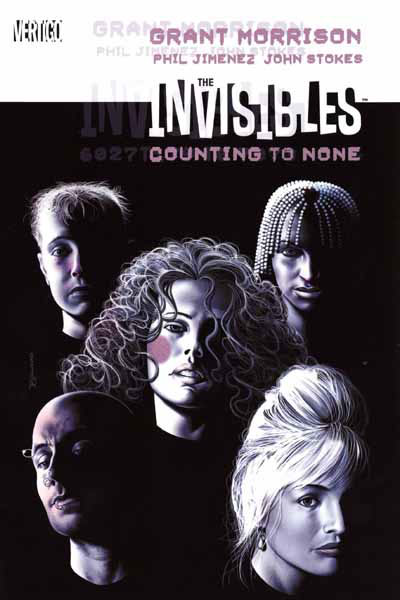 Then again, The Invisibles suffers from the opposite problem, as well; it can get just too goshdarn convoluted. I’m not even really talking about complicated plot, here, but rather complicated…well, storytelling! This, however, I’m much more forgiving of, just because it is Grant Morrison being ambitious and testing the limits of just how to tell a story. This is Grant “I built a fiction-suit to interact with two-dimensional characters” Morrison, after all, who is also looking to bust up the narrative structure and tell a story in a different way. Part of striving to clear the next hurdle is falling down. Sure, sometimes the fragmented nature of the story doesn’t work, but I consider it a necessary side-effect of the times when it does work. More of what I mean by “young work.” Grant Morrison plays around with the reader, and learns some new tricks to boot.
Then again, The Invisibles suffers from the opposite problem, as well; it can get just too goshdarn convoluted. I’m not even really talking about complicated plot, here, but rather complicated…well, storytelling! This, however, I’m much more forgiving of, just because it is Grant Morrison being ambitious and testing the limits of just how to tell a story. This is Grant “I built a fiction-suit to interact with two-dimensional characters” Morrison, after all, who is also looking to bust up the narrative structure and tell a story in a different way. Part of striving to clear the next hurdle is falling down. Sure, sometimes the fragmented nature of the story doesn’t work, but I consider it a necessary side-effect of the times when it does work. More of what I mean by “young work.” Grant Morrison plays around with the reader, and learns some new tricks to boot.
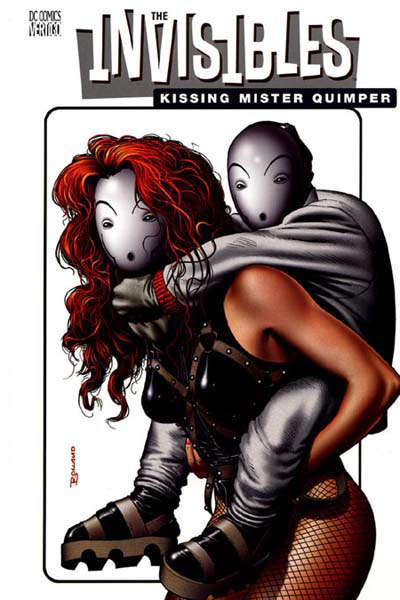 Ultimately though, the ambition of this—more of the “young work” symptom—is in how personal it is. Read Morrison’s Supergods: it is a fairly insightful look at the history of comicbooks…until Grant Morrison starts writing comics, at which point it morphs into something altogether more autobiographical. Because it is him, right? He’s writing the dang things, now. Personal. Then beyond that, he discusses his experiences with shamanism and theophany. The Invisibles is the same thing; it is his attempt to use fiction to communicate the same ideas. Not to tell you, not to spoon feed you, but to share it with you. The Invisibles is a story designed to change who you are. It is a fable, it encodes the information Grant Morrison thinks you need to achieve gnosis. It pushes boundaries to…well, to push the boundaries, to break them if it can. It doesn’t always work, but then it does, and it is beautiful.
Ultimately though, the ambition of this—more of the “young work” symptom—is in how personal it is. Read Morrison’s Supergods: it is a fairly insightful look at the history of comicbooks…until Grant Morrison starts writing comics, at which point it morphs into something altogether more autobiographical. Because it is him, right? He’s writing the dang things, now. Personal. Then beyond that, he discusses his experiences with shamanism and theophany. The Invisibles is the same thing; it is his attempt to use fiction to communicate the same ideas. Not to tell you, not to spoon feed you, but to share it with you. The Invisibles is a story designed to change who you are. It is a fable, it encodes the information Grant Morrison thinks you need to achieve gnosis. It pushes boundaries to…well, to push the boundaries, to break them if it can. It doesn’t always work, but then it does, and it is beautiful.
Mordicai Knode sees Barbelith but all he hears is the “ping!” of Mother Box. The “ping!” means Mother Box loves you. You can follow Mordicai on Twitter and Tumblr.










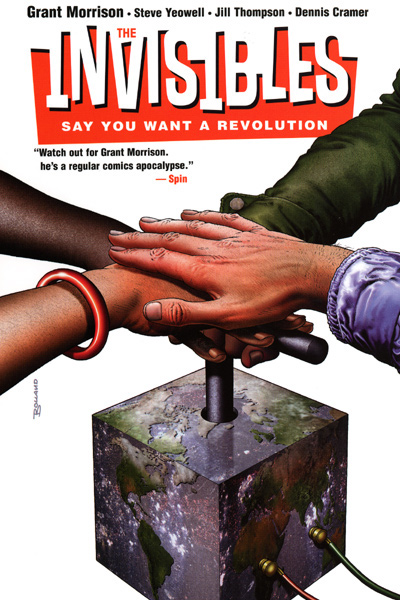
The Invisibles is Grant Morrison trying to give you a magical initiation into the Deeper Mysteries.
I read the Invisibles when I was 23, I think, though my memories of that period of time are foggy at best. Its fair to say that it is a young work, with all the not-quite-thought/lived-through bits that entails, but I agree with what @mordicai said, that Morrison is trying to initiate you into the Deeper Mysteries. He’s providing a door from the darkness into the light fantastic.
I don’t think the Invisible are for everyone. In a way, there is a whole tribe of creators making art that helps those of us that have been hurt or scarred make the emotional leap into loving magic again. Not everyone needs this. My wife, though hurt by life, never turned to darker expressions of her pain, no gothic makeup, no bondage play, no smoking, drugs or blotto behavior. And she would actually be offput by the setup and the throughline of these books, even though she lives and loves the payoff.
But there are those of us that do inhabit a similar world to King Mob and Ragged Robin, that at one stage were wrapped up in hate and anger and refused to see how fun magical thinking can be, how liberating for the spirit. Books like the Invisibles, and like Sandman, music like Amanda Palmer, like Tool, they open doors for people like us, bring us back and let us enjoy life.
2. Yenvious
See, I always (personally) ended up sympathizing less with the iconoclasts & more with the alienated weirdos; the Venn circles are very close & often overlap, but I didn’t really have anyone to hitch my wagon too…besides the writer, I think? & Edith Manning, she was definitely my favorite.
I do wish I could go back in time & read it as a younger man!
Great article!
I think Grant Morrison is one of the greates comic book writer, period. Regarding The Invisibles, I admit that I agree with that “it can get just too goshdarn convoluted”, so this is not the first comic book I advise for a rookie, but it is unavoidable nevertheless. Among the first comic books I advise is the All-Star Superman, which just might be the best Superman comic all time, loveable and deep.
I also loved his WE3, and was fond of the zaniness of SeaGuy, among others, and JLA was both freaking epic and funny at the same time (Flash about Superman: “And this is the guy who thinks he cannot live up to his reputation… just wrestling with an angel!”). I also have to admit that I found his New X-men storyline the best from X-men stories (sans Magneto, which could have been explained so easily with Sublime controlling the Master of Magnetism – just they did with Beast in the story that followed. I think there should be a rule not to depict Magneto without any sympathy or nuance, since the X-men has enough total bastard enemies all ready with the likes of Mister Sinister, Apocalypse or the Morrison-created Cassandra Nova.)
Hmm. My favourite work by Morrison is still his DOOM PATROL run, which predates THE INVISIBLES by several years. Being as early as it is it’s pretty unrestrained with Morrison tossing off ideas in all directions every issue. I reread it recently and there’s an exhuberance to it I don’t see in his later, more controlled work.
4. Hedgehog Dan
We 3 is like a punch in the stomach in book form…& I mean that in a good way! As for X-Men, any time you get Morrison & Quietly on a project together, you know that is a good omen.
5. RobHansen
You know, it is weird that I didn’t mention Doom Patrol, because you are right, it is really great & it is actually cut from a lot of the same cloth.
The Invisibles is probably the best comic ever published.
Like Moridicai, I also started a re-read right around the 2012 apocalypse and am neck deep in the supercontext.
Everyone should read this.
Great high level review–I agree that it does not hold up all that well, but at the time I *loved* this book.
Today, I cannot help reading this & thinking about Moore.
I would love to see a more detailed look at JLA & Invisibles. Like a compare and contrast of the major themes, story telling style, etc.
7. chrisgiff
We made it, Baktun 13!
8. davidgiven
Look mom, “high level!” Who’s wasting their time reading comic books now, mom! LOOK!
Also, the more Moore lashes out at the comic book community, the less I value his statements about verbal agreements & whatnot. Morrison’s rebuttal of Moore’s “takedown” was a pretty well cited little article.
As for the Invisibles versus JLA…that ain’t a bad idea.
Anyone here that is a redditor and loves this comic should check out r/invisibles